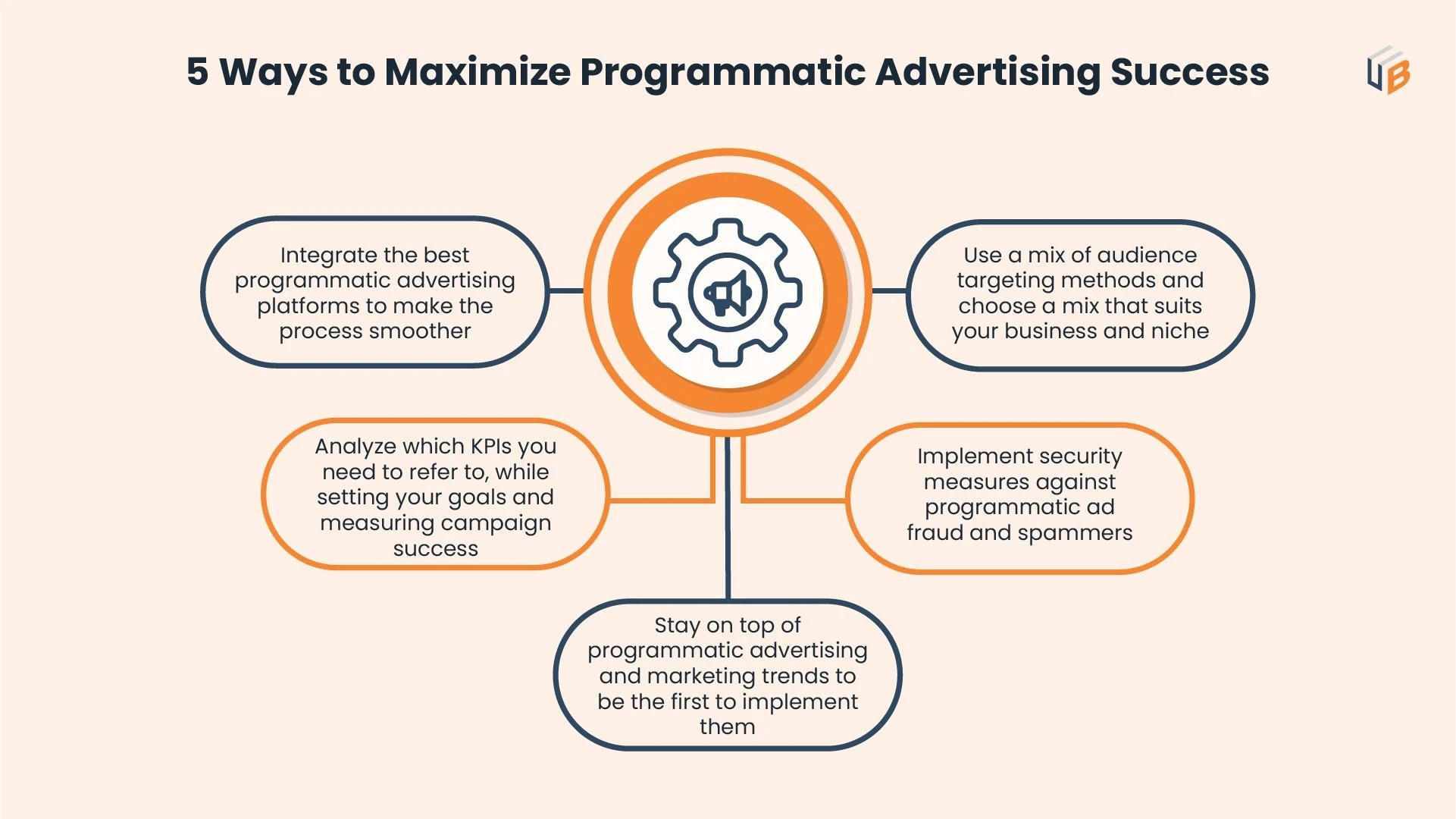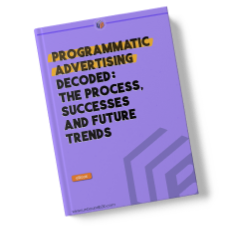
The hype that programmatic advertising is getting in 2024 is incomparable, but why? People who work in paid marketing know-how getting direct deals for publishing ads is a nightmare. There is a huge risk of ad fraud and the real worth of the platform, thanks to the ambiguity of not knowing the real stats of a website. Programmatic advertising is the answer to those problems while providing added benefits like better targeting, and optimization of ads.
But, let’s start from the beginning.
Programmatic Advertising Definition and Its 5-Stage Process
Programmatic advertising is the automated process of buying and selling ad spaces. This media buying process involves an auction of a publisher’s ad inventory. The bidding process and deal agreements vary depending upon the different media buying types that we’ll discuss a bit further. Regardless of the type, the process remains more or less identical. It goes through 5 different stages as shown below.
This 5-stage process revolves around the programmatic media buying process used to facilitate the buying and selling of ads.

Programmatic media buying makes the process of buying and selling digital ads automatic. It uses software and algorithms to connect publishers and advertisers. So, advertisers who want to run ads match with websites that have available ad inventory. The programmatic media buying process occurs in real-time with different types of media buying.
4 Types of Programmatic Media Buying
1. Real-Time Bidding (RTB)
As the name implies, real-time bidding is an instant auction that facilitates buying and selling ads in real-time through bidding for each impression. RTB connects several advertisers with all available ad spaces. There is no preference for specific advertisers, and the highest bidder wins.
The biggest advantage of RTB is the convenient approach that makes it easy for all advertisers and publishers to buy or sell ad spaces.
2. Private Marketplace (PMP)
Private marketplace is a programmatic media buying type that holds auctions only for specific advertisers invited by the publisher. In PMP, high-quality publishers offer their premium, exclusive ad spaces where the highest bidder within the selected advertisers wins.
Publishers with a valuable platform and ad inventory can benefit from higher bids from advertisers of their own choice. While advertisers can access those high-value platforms to target their niche audience.
3. Programmatic Guaranteed
Programmatic guaranteed type of media buying is like a direct sale of the ad spaces. Advertisers and publishers can conduct a direct negotiation for the ad inventory and come to an agreement. This method bypasses an auction and if both parties agree on the terms, they can move ahead with the campaign.
Since there is no auction, advertisers can reliably run ads without having to compete with others. On the other hand, publishers can sell their ad spaces on their own terms.
4. Preferred Deals
Preferred deals is the least common type of media buying that only offers advertisers preferential access to the inventory. Preferential access means that an advertiser who made a deal with the publisher gets to be the first, preferred buyer when the publisher wants to sell.
Preferred deals only guarantee the priority and not the sale. So, if an advertiser doesn’t want to buy it, they don’t have to go ahead with the sale. This can leave the publisher without any buyers. So, the ideal way to include preferred deals is with a backup option to run an RTB auction.
The Difference Between Direct and Programmatic Advertising
In programmatic advertising, media buying happens through an auction that is either public or private. As far as direct advertising is concerned, publishers directly make a deal with advertisers.
On the surface, programmatic and direct advertising seem identical apart from the media buying process. However, there are 7 key differentiating factors for direct vs. programmatic advertising.
| Sr.No | Factor | Programmatic Ads | Direct Ads |
| 1. | Cost Estimations | Depends on the value of the publisher’s ad inventory. Varies greatly with multiple bidders. | Fixed CPM that both parties agree on. |
| 2. | Data Collection and Management | Data management platforms support the gathering, organizing, and saving of data through campaigns on both sides. | No viable sources of data collection and management for the advertiser. Publishers can use DMP or other analytics tools. |
| 3. | Targeting Options | Target users based on multiple factors using different targeting types mentioned in this article. | Only target the existing niche/audience of the publisher. |
| 4. | Personalization | Access data collection and targeting tools for greater personalization. Real-time modifications can also help you with dynamic, personalized adjustments. | Personalization based on the existing user data of the publisher and no scope for real-time changes. |
| 5. | Analytics & Optimization | Real-time updates and results to analyze your campaigns and make adjustments on the go. | No control of campaigns during or after completion. Publishers might give you the data, but it usually isn’t guaranteed. |
| 6. | Anti-fraud Solutions | Plenty of integrations for all possible ad fraud scenarios. The risk of ad fraud is somewhat higher due to added entities and 3rd party platforms. | Limited integrations for anti-fraud solutions, but not needed for trusted platforms. Publishers can access anti-fraud solutions to avoid action or impression frauds like fake clicks and traffic. |
| 7. | Flexibility | Highly flexible with customized targeting, personalization, and optimization. | Pretty much set and go without any adjustments or high-level targeting. |
These differences don’t mean that one is better than the other. If you really want your paid marketing strategy to be successful, it is wise to include both of these in some capacity depending upon your goals, budget, and product.
If you are looking to implement B2B advertising in your business, explore how UnboundB2B’s advertising services can help you achieve your goals!

How to Make the Most of Your Programmatic Advertising Campaigns?
The best part of implementing programmatic advertising in your paid marketing strategy is some of the benefits we discussed earlier. You get access to several important features and can reach your target prospects with precision. With these benefits in mind, there are 3 main things you need to focus on.

1. Integrating the Best Programmatic Advertising Platforms
Programmatic Advertising needs platforms that connect advertisers and publishers. With these tools, concepts like real-time bidding and ad management can work seamlessly. There are 7 main platforms you need to be familiar with.
- Demand-Side Platform (DSP): Allows advertisers to buy ad spaces and inventories. It connects them to ad exchanges and networks, to check and buy available inventories. A DSP is a must for advertisers.
- Supply-Side Platform (SSP): Allows publishers to connect with ad exchanges and DSPs to sell their ad inventory. It gives them control over selecting specific ad spaces and helps monitor the type of ads displayed.
- Ad Exchange: As the middle-ground for the programmatic media buying process where advertisers and publishers connect. An ad exchange connects the advertiser’s DSP and the publisher’s SSP.
- Ad Server: Manages ad deliveries and storage, tracks ad impressions, and measures the overall performance of the ad campaign.
- Data Management Platform (DMP): A platform used to collect, store, and organize data about users and campaigns. Both advertisers and publishers can use a DMP to make informed decisions and changes to the campaign.
- Asset Management Platform (AMP): A platform to help you store, organize, share, and protect your digital assets. Having an AMP will centralize assets for your access and delivery.
- Consent Management Platform (CMP): Allows publishers to collect and manage user data while complying with policies like GDPR and CCPA. CMPs also provide users with a clear and concise way to understand how their data is being collected and used.
Popular programmatic advertising suites like Amazon Advertising and Adobe Advertising Cloud will cover most of these platforms. But, you don’t have to stick to just one. You can always integrate multiple platforms for your programmatic advertising campaigns.
2. Audience Targeting Methods
Next up, you need to understand the right targeting methods for your audience to make the best of your programmatic ads. Before you jump to any specific targeting method, you need to answer 4 important questions. What does your product/service do? Who benefits from it? What industry standards dictate the market? And what your end goal with programmatic ads is.
Once you’ve understood those parameters, you can choose one or a mix of the following targeting methods:
- Audience/Demographic Targeting: Here, you specify your audience segment by identifying demographic details about them. These could be gender, age, location, income group, occupation, parental status, and interests.
- Contextual/Keyword Targeting: Here, you target an audience based on keywords that show user intent. These keywords can be commercial, informational, navigational, and transactional.
- Geotargeting: Here, you add filters using zip codes or general areas to target users from those locations. An example of such searches can be “Postal services near me”.
- Behavioral Targeting: Here you analyze user’s actions and identify suitable products that might interest them. Most websites store cookie data that you can use for behavioral targeting.
- Remarketing: Here, you target users who have already visited your website or interacted with your digital presence.
If you want to learn about real-time case studies and future trends in programmatic advertising, do not forget to check out UnboundB2B’s programmatic advertising ebook for free.

3. Setting the Right KPIs
The best way to miss out on the great benefits of programmatic advertising is to dive in aimlessly and without a goal. If you’re not keen on that, you need to know and identify your programmatic advertising KPIs. They’ll help you measure the success of your campaigns and give a realistic estimation of your ROI.
The top 10 KPIs you need to know are:
- Impressions: The number of times that the ad is displayed during the campaign
- Clicks: The number of clicks your ad/CTA received
- Click-Through Rate (CTR): It is the percentage of people who clicked on your ad
- Cost Per Click (CPC): The cost of each user engagement/click for your ad
- Unique Impressions: The number of times that the ad is displayed to unique visitors
- Viewability: It is the percentage of ads that your target audience can actually see
- Frequency: The number of times an ad is displayed to an individual user over a given period of time
- Conversions: The number of people that end up taking the desired action behind any ad
- Cost Per Acquisition (CPA): It is the cost of getting a single customer to complete a given action
- Return on Ad Spend (ROAS): The return a company gets for each dollar it spends on ads
KPIs are like your North Star for programmatic advertising. They dictate everything from your targeting strategy to CTA copy. So, make sure you understand your goals behind the campaign and identify your important KPIs.
4. Protection Against Ad Fraud
To make the best out of your programmatic ad campaigns, they need to be safe and away from malpractices and ad fraud. As per reports from Statista, ad fraud led to a loss of $81 billion last year.
If you want to avoid being a victim of this, you need to identify the types of ad fraud. Some of the most common ad fraud types are cookie stuffing, bot traffic, click and impressions fraud, domain spoofing, and hidden advertising.
All of these can severely cripple your ad campaign’s performance or worse, give you inaccurate results that seem great, but aren’t. You can combat these malpractices by implementing security policies, working on trusted networks, using the most reputable tools, and educating your team. Some of the factors to keep in mind are:
- IP Blocking: Assess IP addresses to find any association with ad fraud and block them.
- Anomaly or Pattern Detection: Point out any ad fraud happening with your campaigns by identifying certain patterns or anomalies.
- Proxy and VPN Detection: Identify and block scammers trying to camouflage under a proxy server or VPN.
- Click Verification: Identify genuine actions by verifying clicks by tracking the user’s session, referrer analysis, and time-based validation.
- Ad Viewability: Assess and rank the ad viewability to avoid hidden advertising or ad stacking frauds.
When these things are taken care of, your programmatic ad campaigns are safe.
5. Following the Trends
Just like any other marketing practice, programmatic advertising evolves fast, thanks to a heavy reliance on technology and direct interaction with the audience. Emerging programmatic advertising trends like the elimination of third-party cookies and increasing reliance on first-party data to combat it.
Some other notable trends include an increased integration of AI and ML in programmatic advertising. This doesn’t just apply to media buying and hosting, but also to the creation of ad copy using AI tools if you’re in a jiffy.
Regardless of the trends, the point remains. Inculcating the latest and best helps you capitalize on being the first to act and gain from those trends.
The Future of Paid Marketing
As it stands, paid marketing is not exactly the first thing that marketers go for, considering the massive budget cuts in 2023. But, most companies and marketing teams are getting accustomed to it and programmatic advertising will have a prominent role in B2B demand generation soon.
If you don’t want to miss the train, you need to implement programmatic advertising in your marketing mix. The best way to do that? Work with an external marketing agency to run the campaigns and generate high-quality leads.
At UnboundB2B, we use multiple demand generation strategies to generate leads that convert. One of those solutions is B2B paid marketing services. We run programmatic advertising campaigns on optimized landing pages targeted towards your ICP. Other than generating leads, we also focus on qualifying them and making them sales-ready based on your requirements.
Boost your marketing outcomes with B2B advertising solutions! Explore UnboundB2B’s paid marketing services for enhanced marketing ROI.
Our blog
Latest blog posts
Tool and strategies modern teams need to help their companies grow.

Generative AI in B2B marketing represents more than a passing trend because it active...

Personalization functions as the vital foundation for executing B2B marketing effecti...

Beat your competitors and exceed your revenue goals this year by shifting your focus ...





